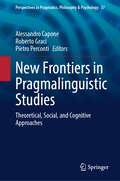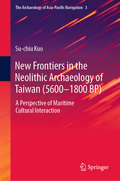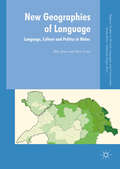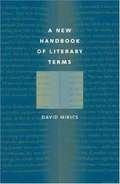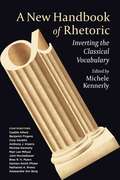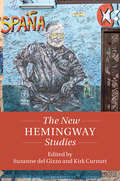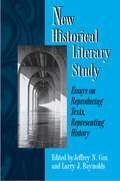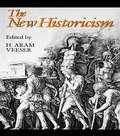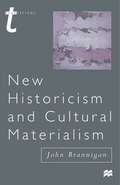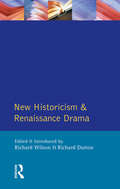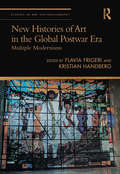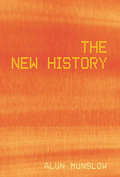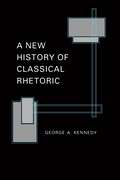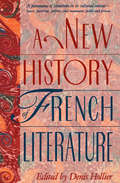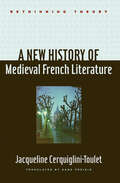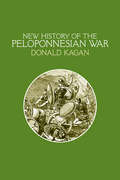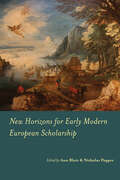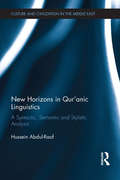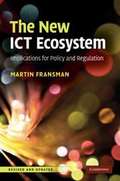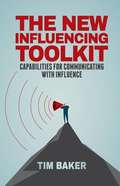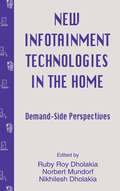- Table View
- List View
New Frontiers in Pragmalinguistic Studies: Theoretical, Social, and Cognitive Approaches (Perspectives in Pragmatics, Philosophy & Psychology #37)
by Alessandro Capone Roberto Graci Pietro PercontiThis book contains a comprehensive view of pragmalinguistic studies and their recent ramifications, boasting some of the most advanced recent research in pragmatics. Organised into three sections—pragmalinguistics, social pragmatics, and cognitive-inferential pragmatics, respectively—the chapters enable an understanding of the possible applications of linguistic and philosophical theories in practical fields. Covering topics such as polysemy across languages and lexical externalism, the role of literal meaning in the construction of metaphorical meaning, the pragmatics of truth, the roles of reflexivity in meaning negotiation, argumentation and discourse, the pragmatics of taboo, linguistic and cognitive aspects of formation of implicates, and reflections on neuropragmatics and clinical pragmatics in Autism Spectrum Disorder and Schizophrenia—to name but a few exciting areas of exploration—this book is of interest to scholars and postgraduate students in the fields of semantics, pragmatics and philosophy of language, cognitive science, and other areas of linguistics.
New Frontiers in the Neolithic Archaeology of Taiwan: A Perspective of Maritime Cultural Interaction (The Archaeology of Asia-Pacific Navigation #3)
by Su-chiu KuoThis book summarizes the systematic research on the Neolithic cultures of Taiwan, based on the latest archaeological discoveries, and focusing on the maritime interactions between mainland southeast China, Taiwan, and southeast Asia during (5600-1800 BP). The study demonstrates and sheds light on the distinctiveness of Taiwan’s Neolithic cultures, their interactions with the external cultures of its surrounding regions, the maritime cultural diffusion and early seafaring across sea regions like the Taiwan Strait, Bashi channel and South China Sea. Drawing on the author’s deep understanding of Taiwan and its surrounding regions, the book also incorporates recent archeological findings by Taiwanese researchers. Further, based on a new reconstruction of the spatiotemporal framework of Taiwanese prehistoric cultures, the chronologically arranged chapters discuss Neolithic cultures of the early, middle, late and final stage of this island region, revealing the prehistoric cultural development, regional typology and their maritime interactions with surrounding regions. The typological study of the native traits and external cultural influences of each stage of Neolithic culture shows the prehistoric and early history of this key stepping stone in the Asia-Pacific region.
New Geographies of Language: Language, Culture and Politics in Wales (Palgrave Studies in Minority Languages and Communities)
by Rhys Jones Huw LewisThis book develops a novel approach to the study of language, bringing it into dialogue with the latest geographical concepts and concerns and provides a comprehensive account of the geography of Welsh language analysing policy development, language use, ability and shift. The authors examine in particular: the different ways in which languages can be mapped; how geographical insights can be used to develop understandings of language use; the value of assemblage theory as a way of interpreting the social, technical and spatial aspects of language policy development; and the geographies that characterise institutional engagements with languages. This book will set a research agenda for the geographical study of language, developing a conceptual framework that will offer fresh insights to researchers in the fields of Applied Linguistics, Sociolinguistics, Minority Languages, Geolinguistics, and Public Policy.
A New Handbook of Literary Terms
by David MikicsA New Handbook of Literary Terms offers a lively, informative guide to words and concepts that every student of literature needs to know. Mikics's definitions are essayistic, witty, learned, and always a pleasure to read. They sketch the derivation and history of each term, including especially lucid explanations of verse forms and providing a firm sense of literary periods and movements from classicism to postmodernism. The Handbook also supplies a helpful map to the intricate and at times confusing terrain of literary theory at the beginning of the twenty-first century: the author has designated a series of terms, from New Criticism to queer theory, that serves as a concise but thorough introduction to recent developments in literary study. Mikics's Handbook is ideal for classroom use at all levels, from freshman to graduate. Instructors can assign individual entries, many of which are well-shaped essays in their own right. Useful bibliographical suggestions are given at the end of most entries. The Handbook's enjoyable style and thoughtful perspective will encourage students to browse and learn more. Every reader of literature will want to own this compact, delightfully written guide.
A New Handbook of Rhetoric: Inverting the Classical Vocabulary
by Michele KennerlyLike every discipline, Rhetorical Studies relies on a technical vocabulary to convey specialized concepts, but few disciplines rely so deeply on a set of terms developed so long ago. Pathos, kairos, doxa, topos—these and others originate from the so-called classical world, which has conferred on them excessive authority. Without jettisoning these rhetorical terms altogether, this handbook addresses critiques of their ongoing relevance, explanatory power, and exclusionary effects.A New Handbook of Rhetoric inverts the terms of classical rhetoric by applying to them the alpha privative, a prefix that expresses absence. Adding the prefix α- to more than a dozen of the most important terms in the field, the contributors to this volume build a new vocabulary for rhetorical inquiry. Essays on apathy, akairos, adoxa, and atopos, among others, explore long-standing disciplinary habits, reveal the denials and privileges inherent in traditional rhetorical inquiry, and theorize new problems and methods. Using this vocabulary in an analysis of current politics, media, and technology, the essays illuminate aspects of contemporary culture that traditional rhetorical theory often overlooks.Innovative and groundbreaking, A New Handbook of Rhetoric at once draws on and unsettles ancient Greek rhetorical terms, opening new avenues for studying values, norms, and phenomena often stymied by the tradition.In addition to the editor, the contributors include Caddie Alford, Benjamin Firgens, Cory Geraths, Anthony J. Irizarry, Mari Lee Mifsud, John Muckelbauer, Bess R. H. Myers, Damien Smith Pfister, Nathaniel A. Rivers, and Alessandra Von Burg.
A New Handbook of Rhetoric: Inverting the Classical Vocabulary
by Michele KennerlyLike every discipline, Rhetorical Studies relies on a technical vocabulary to convey specialized concepts, but few disciplines rely so deeply on a set of terms developed so long ago. Pathos, kairos, doxa, topos—these and others originate from the so-called classical world, which has conferred on them excessive authority. Without jettisoning these rhetorical terms altogether, this handbook addresses critiques of their ongoing relevance, explanatory power, and exclusionary effects.A New Handbook of Rhetoric inverts the terms of classical rhetoric by applying to them the alpha privative, a prefix that expresses absence. Adding the prefix α- to more than a dozen of the most important terms in the field, the contributors to this volume build a new vocabulary for rhetorical inquiry. Essays on apathy, akairos, adoxa, and atopos, among others, explore long-standing disciplinary habits, reveal the denials and privileges inherent in traditional rhetorical inquiry, and theorize new problems and methods. Using this vocabulary in an analysis of current politics, media, and technology, the essays illuminate aspects of contemporary culture that traditional rhetorical theory often overlooks.Innovative and groundbreaking, A New Handbook of Rhetoric at once draws on and unsettles ancient Greek rhetorical terms, opening new avenues for studying values, norms, and phenomena often stymied by the tradition.In addition to the editor, the contributors include Caddie Alford, Benjamin Firgens, Cory Geraths, Anthony J. Irizarry, Mari Lee Mifsud, John Muckelbauer, Bess R. H. Myers, Damien Smith Pfister, Nathaniel A. Rivers, and Alessandra Von Burg.
The New Hemingway Studies (Twenty-First-Century Critical Revisions)
by Kirk CurnuttThe subject of endless biographies, fictional depictions, and critical debate, Ernest Hemingway continues to command attention in popular culture and in literary studies. He remains both a definitive stylist of twentieth-century literature and a case study in what happens to an artist consumed by the spectacle of celebrity. The New Hemingway Studies examines how two decades of new-millennium scholarship confirm his continued relevance to an era that, on the surface, appears so distinct from his—one defined by digital realms, ecological anxiety, and globalization. It explores the various sources (print, archival, digital, and other) through which critics access Hemingway. Highlighting the latest critical trends, the contributors to this volume demonstrate how Hemingway's remarkably durable stories, novels, and essays have served as a lens for understanding preeminent concerns in our own time, including paranoia, trauma, iconicity, and racial, sexual, and national identities.
New Heroes in Antiquity: From Achilles to Antinoos (Revealing Antiquity #18)
by Christopher P. JonesHeroes and heroines in antiquity inhabited a space somewhere between gods and humans. In this detailed, yet brilliantly wide-ranging analysis, Christopher Jones starts from literary heroes such as Achilles and moves to the historical record of those exceptional men and women who were worshiped after death. He asks why and how mortals were heroized, and what exactly becoming a hero entailed in terms of religious action and belief. He proves that the growing popularity of heroizing the dead—fallen warriors, family members, magnanimous citizens—represents not a decline from earlier practice but an adaptation to new contexts and modes of thought. The most famous example of this process is Hadrian’s beloved, Antinoos, who can now be located within an ancient tradition of heroizing extraordinary youths who died prematurely. This book, wholly new and beautifully written, rescues the hero from literary metaphor and vividly restores heroism to the reality of ancient life.
New Historical Literary Study: Essays on Reproducing Texts, Representing History
by Jeffrey N. Cox & Larry J. ReynoldsThis volume, growing out of the celebrated turn toward history in literary criticism, showcases some of the best new historical work being done today in textual theory, literary history, and cultural criticism. The collection brings together for the first time key representativesfrom various schools of historicist scholarship, including leading critics whose work has helped define new historicism. The essays illuminate literary periods ranging from Anglo-Saxon to postmodern, a variety of literary texts that includes The Siege of Thebes, Macbeth, The Jazz Singer, and The Chosen Place, the Timeless People, and central issues that have marked new historicism: power, ideology, textuality, othering, marginality, exile, and liberation. The contributors are Janet Aikins, Lawrence Buell, Ralph Cohen, Margaret Ezell, Stephen Greenblatt, Terence Hoagwood, Jerome McGann, Robert Newman, Katherine O'Keeffe, Lee Patterson, Michael Rogin, Edward Said, and Hortense Spillers. The editors' introduction situates the various essays within contemporary criticism and explores the multiple, contestatory issues at stake within the historicist enterprise.
The New Historicism
by H. Aram VeeserFollowing Clifford Geertz and other cultural anthropologists, the New Historicist critics have evolved a method for describing culture in action. Their "thick descriptions" seize upon an event or anecdote--colonist John Rolfe's conversation with Pocohontas's father, a note found among Nietzsche's papers to the effect that "I have lost my umbrella"--and re-read it to reveal through the analysis of tiny particulars the motive forces controlling a whole society. Contributors: Stephen J. Greenblatt, Louis A. Montrose, Catherine Gallagher, Elizabeth Fox-Genovese, Gerald Graff, Jean Franco, Gayatri Chakravorty Spivak, Frank Lentricchia, Vincent Pecora, Jane Marcus, Jon Klancher, Jonathan Arac, Hayden White, Stanley Fish, Judith Newton, Joel Fineman, John Schaffer, Richard Terdiman, Donald Pease, Brooks Thomas.
New Historicism and Cultural Materialism
by John BranniganNew historicism and cultural materialism emerged in the early 1980s as prominent literary theories and came to represent a revival of interest in history and in historicising literature. Their proponents rejected both formalist criticism and earlier attempts to read literature in its historical context and defined new ways of thinking about literature in relation to history. This study explains the development of these theories and demonstrates both their uses and weaknesses as critical practices. The potential future direction for the theories is explored and the controversial debates about their validity in literary studies are discussed.
The New Historicism and Other Old-Fashioned Topics
by Brook ThomasBrook Thomas explores the new historicism and the challenges posed to it by a postmodern world that questions the very possibility of newness. He considers new historicism's engagement with poststructuralism and locates the former within a tradition of pragmatic historiography in the United States.
New Historicism and Renaissance Drama (Longman Critical Readers)
by Richard Wilson Richard DuttonNew Historicism has been one of the major developments in literary theory over the last decade, both in the USA and Europe. In this book, Wilson and Dutton examine the theories behind New Historicism and its celebrated impact in practice on Renaissance Drama, providing an important collection both for students of the genre and of literary theory.
New Histories of Art in the Global Postwar Era: Multiple Modernisms (Studies in Art Historiography)
by Flavia FrigeriThis book maps key moments in the history of postwar art from a global perspective. The reader is introduced to a new globally oriented approach to art, artists, museums and movements of the postwar era (1945–70). Specifically, this book bridges the gap between historical artistic centers, such as Paris and New York, and peripheral loci. Through case studies, previously unknown networks, circulations, divides and controversies are brought to light. From the development of Ethiopian modernism, to the showcase of Brazilian modernity, this book provides readers with a new set of coordinates and a reassessment of well-trodden art historical narratives around modernism. This book will be of interest to scholars in art historiography, art history, exhibition and curatorial studies, modern art and globalization.
New Histories of Art in the Global Postwar Era: Multiple Modernisms (ISSN)
by Flavia FrigeriThis book maps key moments in the history of postwar art from a global perspective. The reader is introduced to a new globally oriented approach to art, artists, museums and movements of the postwar era (1945–70). Specifically, this book bridges the gap between historical artistic centers, such as Paris and New York, and peripheral loci. Through case studies, previously unknown networks, circulations, divides and controversies are brought to light. From the development of Ethiopian modernism, to the showcase of Brazilian modernity, this book provides readers with a new set of coordinates and a reassessment of well-trodden art historical narratives around modernism. This book will be of interest to scholars in art historiography, art history, exhibition and curatorial studies, modern art and globalization.
The New History
by Alun MunslowThe notion of 'history' has always been one strenuously debated by both academics and the wider population. This deeply provocative re-thinking of our engagement with the past by one of the world's leading post-modern historians takes that debate one step further. Alun Munslow re-assesses history in the light of post-modernism and other intellectual challenges which have questioned the primacy of the modernist epistemology of empiricism. In an original and stimulating vision of history that will intrigue all those seriously interested in the subject, Munslow argues that history is not only about the sources, but a literary construction. Munslow concludes that history, as a cultural narrative about the past can never tell us what the past really means. This far reaching conclusion is based on the radical idea that the content of history is defined as much by the nature of the language used to represent and interpret that content as it is by research into the sources. This suggests that history does not produce the most likely meaning of the past but rather can only generate alternative meanings. The lead volume in a major new series on historical thinking and practice, this is an accessible yet absorbing study that breaks new ground in discussing the stage history is at now, and perhaps most engagingly, the direction it will take in the future.
A New History of Classical Rhetoric
by George A. KennedyGeorge Kennedy's three volumes on classical rhetoric have long been regarded as authoritative treatments of the subject. This new volume, an extensive revision and abridgment of The Art of Persuasion in Greece, The Art of Rhetoric in the Roman World, and Greek Rhetoric under Christian Emperors, provides a comprehensive history of classical rhetoric, one that is sure to become a standard for its time. Kennedy begins by identifying the rhetorical features of early Greek literature that anticipated the formulation of "metarhetoric," or a theory of rhetoric, in the fifth and fourth centuries b.c.e. and then traces the development of that theory through the Greco-Roman period. He gives an account of the teaching of literary and oral composition in schools, and of Greek and Latin oratory as the primary rhetorical genre. He also discusses the overlapping disciplines of ancient philosophy and religion and their interaction with rhetoric. The result is a broad and engaging history of classical rhetoric that will prove especially useful for students and for others who want an overview of classical rhetoric in condensed form.
A New History of French Literature
by Denis Hollier R. Howard Bloch Peter Brooks Joan DeJean Barbara Johnson Philip E. Lewis Nancy K. Miller François Rigolot Nancy J. VickersDesigned for the general reader, this splendid introduction to French literature from 842 A.D.—the date of the earliest surviving document in any Romance language—to the present decade is the most compact and imaginative single-volume guide available in English to the French literary tradition. In fact, no comparable work exists in either language. It is not the customary inventory of authors and titles but rather a collection of wide-angled views of historical and cultural phenomena. It sets before us writers, public figures, criminals, saints, and monarchs, as well as religious, cultural, and social revolutions. It gives us books, paintings, public monuments, even TV shows. Written by 164 American and European specialists, the essays are introduced by date and arranged in chronological order, but here ends the book’s resemblance to the usual history of literature. Each date is followed by a headline evoking an event that indicates the chronological point of departure. Usually the event is literary—the publication of an original work, a journal, a translation, the first performance of a play, the death of an author—but some events are literary only in terms of their repercussions and resonances. Essays devoted to a genre exist alongside essays devoted to one book, institutions are presented side by side with literary movements, and large surveys appear next to detailed discussions of specific landmarks. No article is limited to the “life and works” of a single author. Proust, for example, appears through various lenses: fleetingly, in 1701, apropos of Antoine Galland’s translation of The Thousand and One Nights; in 1898, in connection with the Dreyfus Affair; in 1905, on the occasion of the law on the separation of church and state; in 1911, in relation to Gide and their different treatments of homosexuality; and at his death in 1922. Without attempting to cover every author, work, and cultural development since the Serments de Strasbourg in 842, this history succeeds in being both informative and critical about the more than 1,000 years it describes. The contributors offer us a chance to appreciate not only French culture but also the major critical positions in literary studies today. A New History of French Literature will be essential reading for all engaged in the study of French culture and for all who are interested in it. It is an authoritative, lively, and readable volume.
A New History of Medieval French Literature (Rethinking Theory)
by Jacqueline Cerquiglini-TouletIs it legitimate to conceive of and write a history of medieval French literature when the term "literature" as we know it today did not appear until the very end of the Middle Ages? In this novel introduction to French literature of the period, Jacqueline Cerquiglini-Toulet says yes, arguing that a profound literary consciousness did exist at the time.Cerquiglini-Toulet challenges the standard ways of reading and evaluating literature, considering medieval literature not as separate from that in other eras but as part of the broader tradition of world literature. Her vast and learned readings of both canonical and lesser-known works pose crucial questions about, among other things, the notion of otherness, the meaning of change and stability, and the relationship of medieval literature with theology. Part history of literature, part theoretical criticism, this book reshapes the language and content of medieval works. By weaving together topics such as the origin of epic and lyric poetry, Latin-French bilingualism, women’s writing, grammar, authorship, and more, Cerquiglini-Toulet does nothing less than redefine both philosophical and literary approaches to medieval French literature. Her book is a history of the literary act, a history of words, a history of ideas and works—monuments rather than documents—that calls into question modern concepts of literature.
New History of the Peloponnesian War
by Donald KaganA New History of the Peloponnesian War is an ebook-only omnibus edition that includes all four volumes of Donald Kagan's acclaimed account of the war between Athens and Sparta (431–404 B.C.): The Outbreak of the Peloponnesian War, The Archidamian War, The Peace of Nicias and the Sicilian Expedition, and The Fall of the Athenian Empire. Reviewing the four-volume set in The New Yorker, George Steiner wrote, "The temptation to acclaim Kagan's four volumes as the foremost work of history produced in North America in the twentieth century is vivid. . . . Here is an achievement that not only honors the criteria of dispassion and of unstinting scruple which mark the best of modern historicism but honors its readers." All four volumes are also sold separately as both print books and ebooks.
New Horizons for Early Modern European Scholarship
by Ann Blair and Nicholas PopperAn illuminating exploration of the new frontiers—and unsettled geographical, temporal, and thematic borders—of early modern European history.The study of early modern Europe has long been the source of some of the most creative and influential movements in historical scholarship. New Horizons for Early Modern European Scholarship explores recent developments in historiography both to exhibit the field's continuing vibrancy and to highlight emerging challenges to long-assumed truths. Essays examine • how key ideas and intellectual practices arose, circulated through scholarly culture, and gave way to subsequent forms • Europe's transforming relationship with Asia, the Americas, Africa, and the rest of the world• how overlooked evidence illuminates vital but obscured people, practices, and objects • connections between disciplines, types of sources, time periods, and placesOpening up emerging possibilities, this book demonstrates that early modern European scholarship remains a source for groundbreaking historical insights and methodologies that would benefit the study of any time and place. Contributors: Alexander Bevilacqua, Ann Blair, Daniela Bleichmar, William J. Bulman, Frederic Clark, Anthony Grafton, Jill Kraye, Yuen-Gen Liang, Elizabeth McCahill, Nicholas Popper, Amanda Wunder
New Horizons in Qur'anic Linguistics: A Syntactic, Semantic and Stylistic Analysis (Culture and Civilization in the Middle East)
by Hussein Abdul-RaofNew Horizons in Qur'anic Linguistics provides a panoramic insight into the Qur'anic landscape fenced by innate syntactic, semantic and stylistic landmarks where context and meaning have closed ranks to impact morphological form in order to achieve variegated illocutionary forces. It provides a comprehensive account of the recurrent syntactic, stylistic, morphological, lexical, cultural, and phonological voids that are an iceberg looming in the horizon of Qur'anic genre. It is an invaluable resource for contrastive linguistics, translation studies, and corpus linguistics. Among the linguistic topics are: syntactic structures, ellipsis, synonymy, polysemy, semantic redundancy, incongruity, and contrastiveness, selection restriction rule, componential features, collocation, cyclical modification, foregrounding, backgrounding, pragmatic functions and categories of shift, pragmatic distinction between verbal and nominal sentences, morpho-semantic features of lexical items, context-sensitive word and phrase order, vowel points and phonetic variation. The value of European theoretical linguistics to the analysis of the Qur’anic text at a macro level has been overlooked in the academic literature to date and this book addresses this research gap, providing a key resource for students and scholars of linguistics and specifically working in Arabic or Qur’anic Studies.
The New ICT Ecosystem
by Martin FransmanThe ICT sector is crucial as a driver of economic and social growth. Not only is it an important industry in its own right, but it also provides the communication and infrastructure without which modern economies could not function. How does this sector work? Why is it stronger in some countries than in others? What should companies, governments and regulators be doing to enhance its contribution? In The New ICT Ecosystem, Martin Fransman answers these and other questions by developing the idea of the ICT sector as an evolving ecosystem. He shows that some components of the ICT ecosystem, particularly the innovation process, work better in some countries and regions (e. g. the USA) than in others (e. g. Europe and the developing world). This enables policy makers and regulators to understand why some parts of the ICT ecosystem are underperforming and what can be done to enhance their performance. The previous edition of The New ICT Ecosystem won the 2008-09 Joseph Schumpeter Prize.
The New Influencing Toolkit
by Tim BakerWithout influence, managers are ineffective. In today's workplace, managers need to influence up, down and increasingly, sideways as organizations become less hierarchical. This book is expertly designed to diagnose and develop managerial influence, focusing on four key strategies: investigating, calculating, motivating and collaborating.
New infotainment Technologies in the Home: Demand-side Perspectives (Routledge Communication Series)
by Ruby Roy Dholakia Norbert Mundorf Nikhilesh DholakiaAs the "information superhighway" moves into the home through interactive media, enhanced telecom services, and hybrid appliances, interest continually grows in how consumers adopt and use Information Technology (IT), the strategies IT marketers use to reach consumers, and the public policies that help and protect consumers. USE COPY FROM THIS POINT ON FOR GENERAL CATALOGS... This book presents a unique collection of papers dealing with the demand side issues of new information technologies in the home. The contributors are from business, academia, and the public policy sector and represent many disciplines including communication, marketing, economics, psychology, engineering, and information systems. This book provides one of the best introductions to complex issues such as: * business forces that will shape "Home IT" of the future; * industry structure of the future "Infotainment" mega-business; * factors affecting consumer adoption and use of IT; * international differences in the management of the IT sector; and * public policies that will shape the deployment and use of IT.
